The Visible Light Spectrum and Aviator Sunglasses
Electromagnetic waves are similar to ocean waves. They are produced all day long, every day, and without them, the world we know would not exist.
These waves range from Gamma rays to X-Rays to Ultraviolet rays to Visible Light Waves, and even longer Infrared Waves.
The spectrum of Microwaves to Radio Waves can actually extend to a length greater than a mountain range.
This spectrum is the basis of the information age and of our modern world.
Visible Light
Our eyes perceive leaves as green because wavelengths in the green region of the visible spectrum are reflected while other visible wavelengths are absorbed.
Yet the chlorophyll and the cell structure of the leaf are also reflecting near-infrared light we cannot see.
Light passing through a prism will be split into different colors ranging from red to violet, depending upon how severly the light ray is bent.
All of the colors combined will result in white light, while the absence of colored light is black.
A precision ground glass lens will allow all of the colors reflected off objects to enter our eyes just as though there was nothing between our eyes and the object.
However, other types of lenses like polycarbonate and nylon may impact the amount and color of visible light that our eyes will see.
Visible Light Video
Watch this video to understand more about the visible light spectrum.
Why Is This Important?
This is important because when wearing glasses or sunglasses you want all of the objects seen through the lens to look the same as if there were no lens between your eyes and what you are looking at.
This is why glass lenses that have been appropriately ground to provide absolute true color reception, while plastic or polycarbonate lenses introduce some distortion, particularly at the edges of the lens.
In addition, light rays will interact with the molecular structure of the plastic or polycarbonate lenses, introducing some alteration of color reception.
Further more, there can be some distortion, particularly at the edges of a lens, on lenses made of other materials like polycarbonate or nylon.
Visible Light Transmittance
When considering a pair of aviator sunglasses, it is essential to understand the characteristics of visible light and how it can affect the cost of the sunglasses.
It is also very important to understand that one of the most important considerations when purchasing a pair of sunglasses is the VLT (Visible Light Transmittance) value of the lenses.
VLT is the amount of light allowed to pass through the lens and reach your eyes.
For most people tje ideal VLT value should be in the range of 16%. This means that the tint applied to the lens will block 84% of the visible light from reaching your eyes.
However, there are many good reasonspeople choose sunglasses with lenses that allow much more light into their eyes.
One example would be with sunglasses that a golfer would wear. As the golfer moves around the golf course they encounter all different kinds of lighting situations. The golfer can experience extremely bright light on the tee but very low light when their golf ball finds itself in the shade of a tree.
A line of really great sunglasses for golfers are Scheyden Golf Sunglasses. These sunglasses have lenses with VLT values of 16% and 33% with a bronze tint. The lenses have been dyed in such a way as to enhance the perfect contrast and color for golf.
For example, some sunglasses like the Method Seven sunglasses offer a range of VLT values from 9% through 30%.
With a VLT of 30% you will receive 70% of the available light. This can be useful when operating in areas of low visibility or to better to be able to see objects at some distance away, like airplanes crossing your flight path.
The aviator sunglasses we offer on this website have excellent lenses that provide absolute true color reception and a VLT values ranging from 9% through 30%.
Visit our Shop to see all of our offerings. Keep your eyes cool and protected today, my friend!



About John White a/k/a JetAviator7
p.s. Please share "The Visible Light Spectrum and Aviator Sunglasses" with your friends.





Leave a comment
This site is protected by hCaptcha and the hCaptcha Privacy Policy and Terms of Service apply.